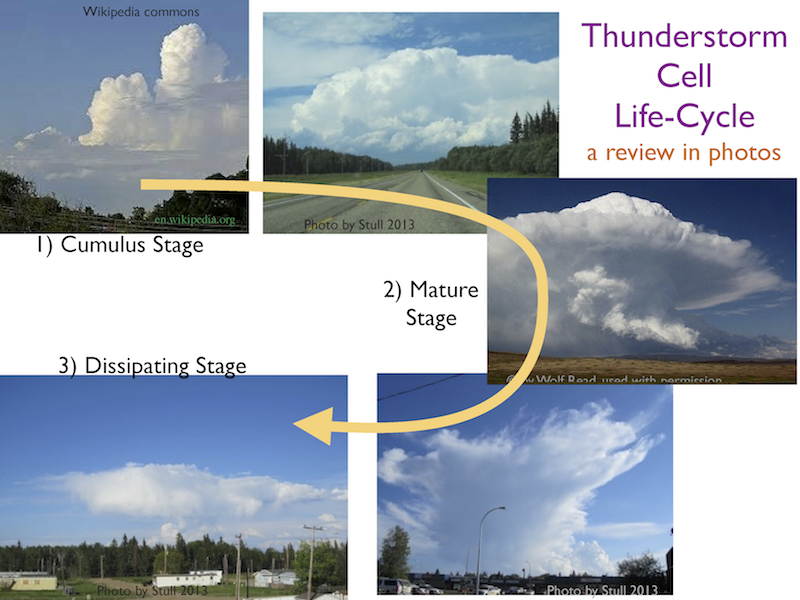Types of Thunderstorms
Learning Goal 4a. Describe thunderstorm cells, the different types of thunderstorms, and their hazards to aviation.
Thunderstorm Cells
Most thunderstorms are composed of cells, where each cell is like an individual thunderstorm (cell diameter ≈ 12 km, depth ≈ 12 km, lifetime ≈ 20 minutes). The photos below show a typical evolution of a thunderstorm cell. The cell evolution stages are:
| Stage | Characteristics |
|---|---|
| 1) Cumulus | Updrafts, no downdrafts. No rain. No anvil (the horizontally-extended upper part of the cloud). Often not visible on radar. |
| 2) Mature | Both up and downdrafts. Rain. Anvil. Most violent stage. Rain portion of cell is visible on radar. |
| 3) Dissipating | Downdrafts, no updrafts. Raining itself out, but leaving ice crystals in the middle and upper parts of the cloud. Not very visible on radar. |
| Residue | Not officially listed as a stage, but
affects pilots because ice crystals in the anvil take a long
time to evaporate. This blocks VFR
(visual) flight
through that region
at the altitude of the anvil cloud. The last photo in the life-cycle image below shows a residual ice-crystal anvil cloud, with no thunderstorm underneath it anymore. |

Note: These are actually photos of different thunderstorms, not the evolution of a single storm.
Some nice YouTube videos illustrating thunderstorm cells and their evolution:
- Diagrams: https://www.youtube.com/watch?v=mRVyle6ptlk
- Time-lapse movies: https://www.youtube.com/watch?v=h6jh4Zp0u08 . You can see the anvil growing at the top of the storm, and you can see rain (grey area under the bottom of the cloud) forming and expanding.
Types of Thunderstorms
Click on the links below to find important aspects of each type of thunderstorm, and how it affects aviation.- Basic
storms
a. single cell (airmass)
b. multicell
c. orographic
- Mesoscale
convective systems (MCS)>
d squall line
e. bow echo
f. mesoscale convective complex (MCC)
g. mesoscale convective vortex (MCV)
- Supercells
h. low precipitation (LP)
i. classic (CL)
j. high precipitation (HP)
==> Click on the key-word links above to see photos and diagrams of these types of thunderstorms.
Preview
Thunderstorms are thick (deep) clouds, with bases near the ground
and tops near the troposphere (about 11 km or 35,000 ft). They
often grow rapidly - - namely, they increase in thickness as the cloud
top rises faster than most civilian aircraft can climb. They have
violent weather that pilots should avoid, as discussed in more detail
in Learning Goals 4b-h.
Key words: thunderstorm, anvil, cells, basic
storms, cumulus
stage, dissipating stage, mature stage, mesoscale convective systems
(MCS), residue, supercells, VFR
Extra info for experts; not needed for this course.
- Stull, 2017: Practical Meteorology. Chapter 14. Thunderstorm Fundamentals.
Image credits. All figures by Roland Stull, except where otherwise noted.